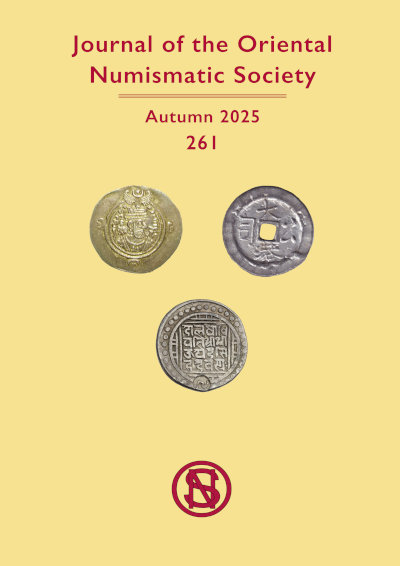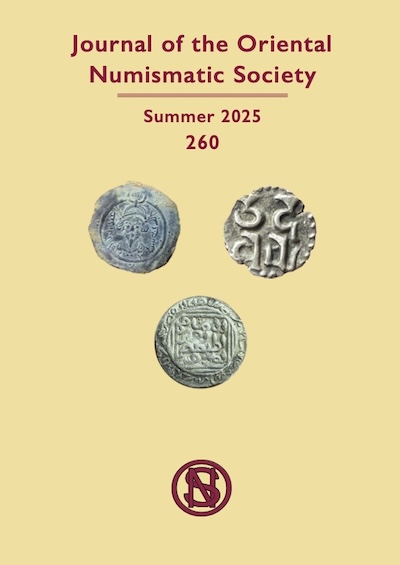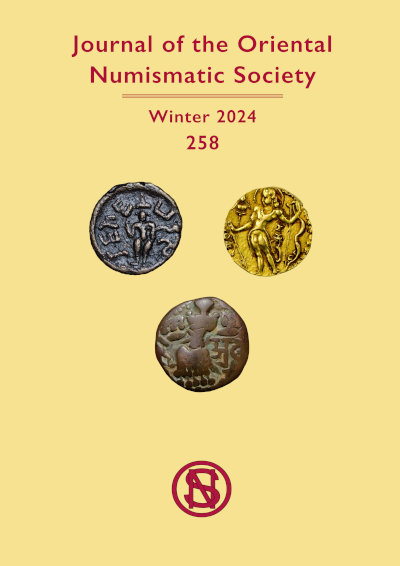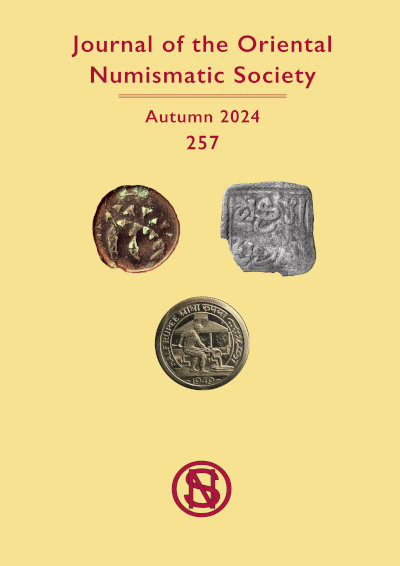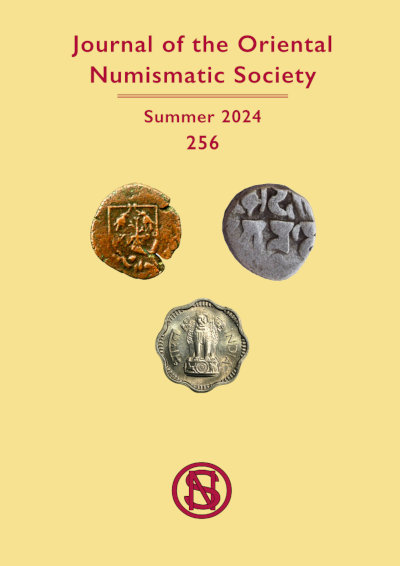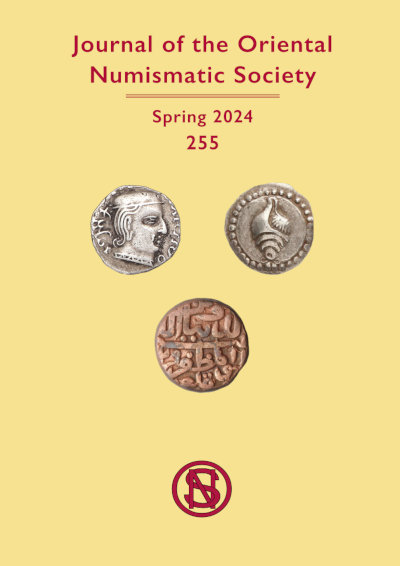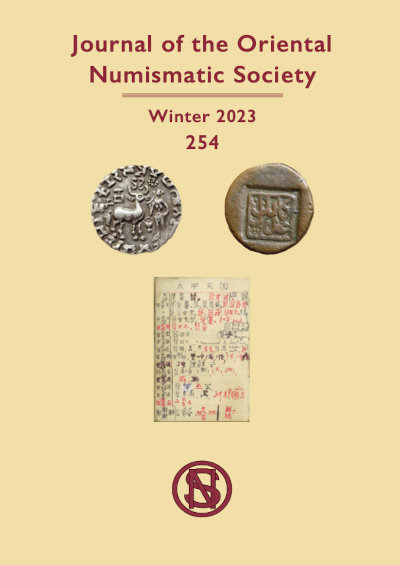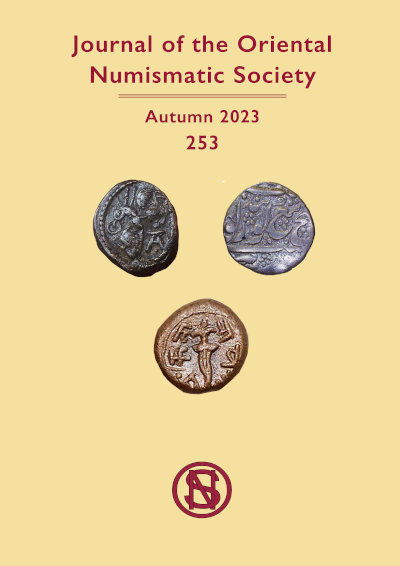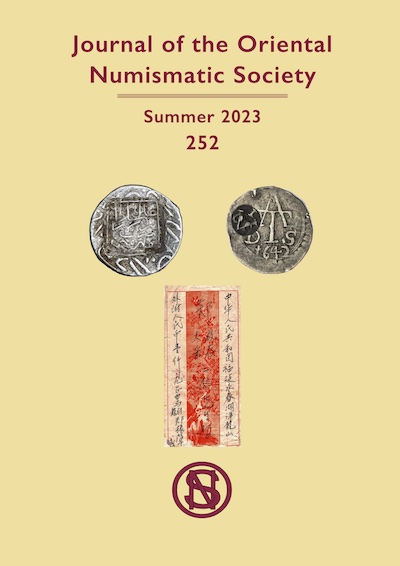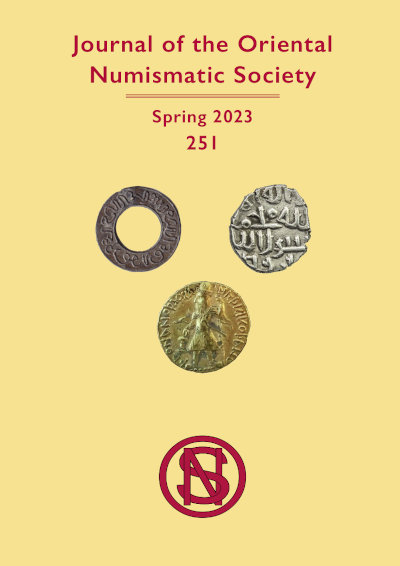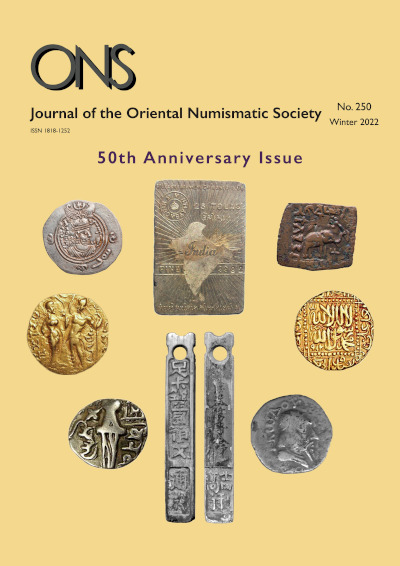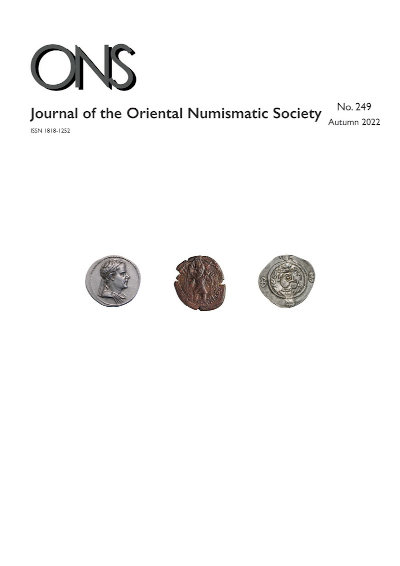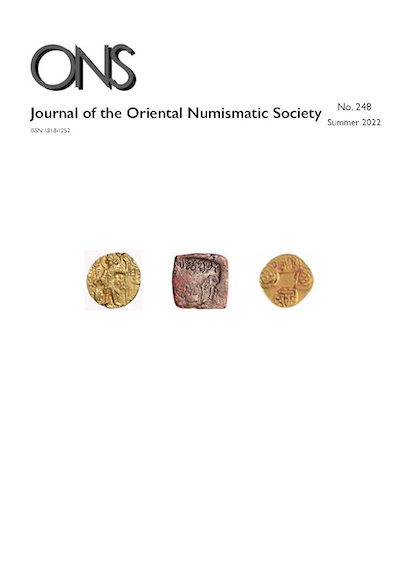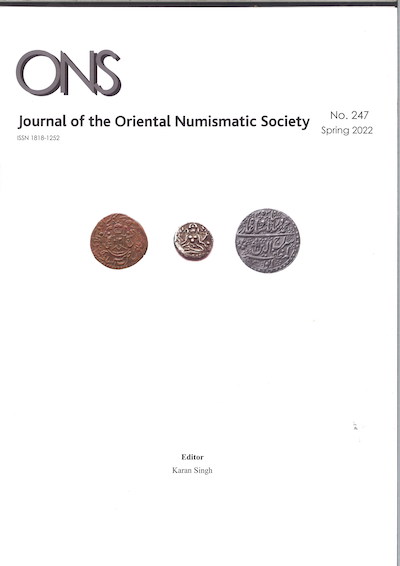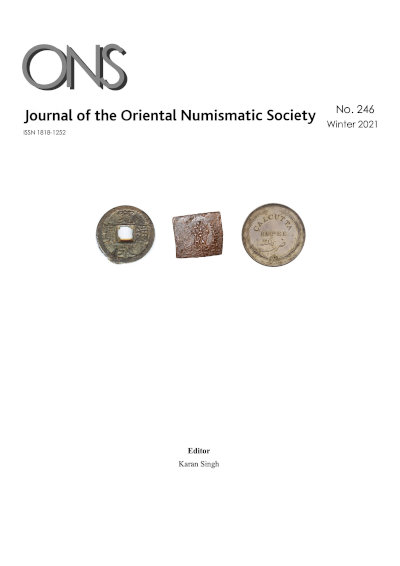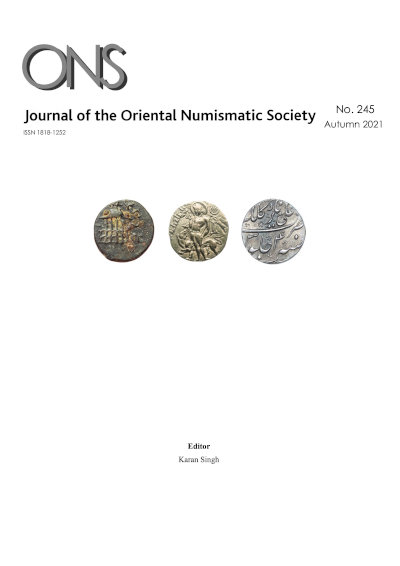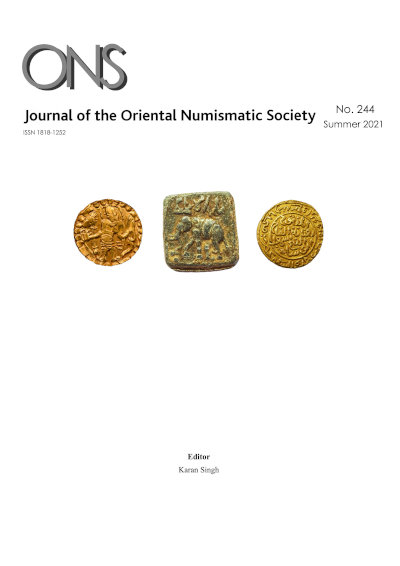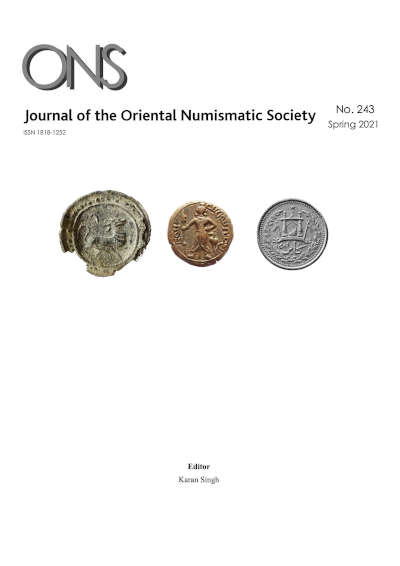Recent Issues
Journal of the Oriental Numismatic Society
The Society’s journal has been published since 1971, initially as the ONS Newsletter and since 2006 as the Journal of the Oriental Numismatic Society. Starting out as a one-paged sheet, it is now an international peer-reviewed publication that is issued quarterly.
Our archive of past issues can be accessed here.
The Society welcomes submissions to the journal from all members. The guidelines can be found at https://www.orientalnumismaticsociety.org/jons/submission-request/.
261: Autumn 2025
| Page | |
|---|---|
| Editorial Pankaj Tandon | 1 |
| A new variant on a copper coin of the Sasanian King Kawad I Nikolaus Schindel This article presents a copper coin of Kawad I that shows an annulet on the obverse at 3h. It is discussed in the context of this king’s coinage, and of the uncommon use of annulets on Sasanian coins. The incomplete preservation of mint and regnal year means that the interpretation remains hypothetical. |
1 |
| An imitation of a solidus of Anastasius from Kafir Kala, the site of ancient Rivdad near Samarkand Aleksandr Naymark, Simone Mantellini and Amriddin Berdymuradov An imitation of a solidus of Anastasius was discovered at Kafir Kala, a site near Samarqand. Damage on the rim of the coin indicates that it was used not as currency but as an item of jewellery, and hence may be described as paranumismatic. Genuine solidi of Anastasius and other emperors from Central Asia are described and other imitations of solidi from the region are discussed. |
3 |
| The Rustam hoard of late Sasanian and Arab-Sasanian coins Joe Cribb and Muhammad Khalid A hoard of late Sasanian and early Arab-Sasanian dirhams was found in the northern region of Gandhāra. The contemporary rulers were Turkic, issuing their own coins, but these coins were minted in Iran and Sistan. The Arab rulers of Sistan were trying to control the region, which explains their presence. A countermark of a winged lion on one of the coins links it with the local Turkic rulers who used a similar device on their coins. It is suggested that the countermark indicates that the coins were checked by the local rulers, and that the practice began in about 673. The significance of the date and other hoards are discussed. |
8 |
| The forgotten Qing dynasty mint and its coinage Tong Yu The study of mints holds significant importance for understanding ancient monetary systems, as well as regional political, economic and military conditions. This article revolves around the discovery of a coin hoard and, combined with relevant archival historical materials, unveils the nearly four-century-old Gansu mint and its coinage varieties. While filling a gap in the research on Qing dynasty mints, it further substantiates the inference that the Da Ming tongbao coin with the character shuai on the reverse was minted in 1648 by Ding Guodong, a leader of the armed anti-Qing and pro-Ming movement, in Ganzhou (today’s Zhangye). |
16 |
| Typology of cash coins of the Borneo Da Gang gongsis Tjong Yih Tin cash coins issued in the nineteenth century by the gold-mining organizations on Borneo known as gonsis are well known but rare and only a few examples have been published. This study uses 152 pieces from a known total of 172 to present a preliminary typology of them. |
21 |
| ‘Badabad’ Herat and the ‘rat series’ copper coins Bernard Millancourt Examples of civic copper fulus, in circulation in Iran and Central Asia from the fourteenth to the nineteenth centuries, are commonly found in collections but the series is poorly studied. In this article examples from Herat in Afghanistan bearing a rat design are discussed, with a suggested reading for the so far undeciphered legend. |
23 |
| A token featuring a folk story from Punjab Jeevandeep Singh This paper explores a fascinating token from Punjab, offering new suggestions for its identity. The token was published as ‘miscellaneous token no. 1’ by Brotman but its iconography remains a mystery, and it has been suggested that it could represent a Sikh theme, Hindu deities or scenes from Punjabi folklore. This study includes a reading of the legend and suggests that it may commemorate the Vikrama Era year 2000. |
25 |
| Comment on article by Gholami in JONS 260 | 26 |
| ONS News | 27 |
| The Nicholas Rhodes Collection of Nepalese Coins and Medals Part One Georgie Potter | 30 |
| Book reviews and notice | 31 |
260: Summer 2025
| Page | |
|---|---|
| Editorial Paula Turner | 1 |
| Copper coins of Aulikara ruler Yaśodharman-Vishṇuvardhana Devendra Handa Inscriptions and other archaeological relics from the city of Mandsaur and the surrounding region reveal that it was the capital of the Aulikaras of more than one dynasty. The first epigraph was discovered in 1879 and a copy made by eye was sent to Alexander Cunningham, who referred to J. F. Fleet who, intrigued by the name of Mihirakula in it, visited the site himself and edited the inscription which recorded the achievements of Yaśodharman–Viṣṇuvardhana about whom nothing was known. It was in 1983 that another very significant inscription recovered from the village of Rīsthal near Mandsaur was published, throwing fresh light on the family and achievements of Rājādhirāja-Parameśvara Yaśodharman. The present paper describes his coins for the first time. |
1 |
| Transition from Pahlavi to Kufic: numismatic evidence from Zoroastrian and Muslim governors in the early Islamic period Kiarash Gholami This paper aims to identify and analyse the coinage of five local figures, ‘Abd al-Rahmān ibn Abī Sabrah, Masqala ibn Hubayra al-Shaybāni, Ᾱdūršahpūr, Yānbūd and Ᾱtīngušnasp, while also providing insights into the decipherment of Pahlavi and Kufic inscriptions found on five anonymous bronze emissions from the same period. Coins are used with historical documents to present a portrayal of post-Sasanian Persia, accentuating the enduring influence of Sasanian governance and how it adapted under Islamic hegemony. The importance of numismatic evidence in the study of early Islamic administrative history is stressed and the transition of Middle Persian to the use of Arabic equivalents during the formative years of the first century is used as a focus for the linguistic and cultural shifts precipitated by the advent of Islam in Persia. |
3 |
| Attribution of coins to the queens of the Utpala dynasty of medieval Kashmir Gul Rahim Khan This paper deals with the copper coins of Kashmir inscribed with the names ‘Śrī Sugandhādevi’, ‘Śrī Śrī Mahadevya’ and ‘Śrī Kṣillikāradevi’. These figures were the regent queens or rulers of the Utpala dynasty of Kashmir who appeared on the political scene in the tenth century CE. The ruling spans, political role and names of two queens, Sugandhā and Kṣillikā, are confirmed and clearly mentioned in the Rājatarangiṇī V.250–6 and 290. But the name and most probably the titles of many rulers are known only from coins and not from any other sources. The coins of Śrī Kṣillikāradevi are quite new and rare, published here for the first time. The coins of Śrī Śrī Mahadevya are rare and their attribution is suggested in this article. The importance of these queens of the Utpala dynasty is presented here. |
10 |
| The rebel issue of Giyāth al-Dīn Bahādur Shah (720 H–724 H) Arup Kumar Saha The numismatic legacy of Giyāth al-Dīn Bahādur Shah, who ruled Bengal from 720 H to 724 H, offers critical insights into the region’s turbulent political landscape. Although no coins solely in Bahādur Shah’s name are dated 728 H, a select group of coins from 727 H suggests a brief assertion of sovereignty, challenging imperial authority. These rare issues serve as tangible evidence of Bengal’s contested autonomy during the early fourteenth century and offer valuable material for understanding the region’s complex numismatic and political history. |
20 |
| Kollam’s maritime trade relations with Sri Vijaya: numismatic evidence Beena Sarasan The numismatic legacy of Giyāth al-Dīn Bahādur Shah, who ruled Bengal from 720 H to 724 H, offers critical insights into the region’s turbulent political landscape. Although no coins solely in Bahādur Shah’s name are dated 728 H, a select group of coins from 727 H suggests a brief assertion of sovereignty, challenging imperial authority. These rare issues serve as tangible evidence of Bengal’s contested autonomy during the early fourteenth century and offer valuable material for understanding the region’s complex numismatic and political history. Trade between the important town of Kollam in Kerala and Southeast Asia is well documented, and now coins dredged from the Batang Hari river in Sumatra are providing numismatic evidence as well. The coins are very diverse, and this article describes examples of coins of the Venad dynasty, including previously unknown small denominations and an unusual bilingual coin, Chola coins and a coin from Sri Lanka. |
22 |
| ONS News | 26 |
| Book review and notice | 31 |
259: Spring 2025
| Page | |
|---|---|
| Editorial Paula Turner | 1 |
| A new date for an autonomous bronze from Seleukeia on the Tigris Michael J. Connor An autonomous bronze dichalkous portraying Zeus aëtophoros (Zeus with the eagle) from Parthian Seleukeia on the Tigris with a previously unrecorded date is described. |
1 |
| Baijin sanpin: a special set of coins issued by Emperor Wudi of the Han Dynasty Zhang Ruiqi In 119 BC the Chinese emperor Wudi ordered the production of some very unusual coins, known as the baijin sanpin meaning three types of white metal. These coins were unusual as they were made of silver and had images on them, completely out of keeping with previous Chinese coins. They were not a success and were soon abandoned. This article explores the history of their issue and rediscovery and the problem that most surviving examples are made of lead. It also discusses where the idea for making such coins came from. |
2 |
| Some novel coins from Central Asia Shinji Hirano This paper reports on novel types and variations of pre-Islamic coins found in Central Asia. These include Hunnic coins from Tokharistan and Chinese cash-type coins from Sogdiana. These newly discovered coins may provide clues to uncover unknown aspects of history in these regions. |
8 |
| Coins of Jassaka Deva of the Vuppadeva dynasty of Kashmir: an enigma Gul Rahim Khan and Aman ur Rahman The Hindu kings of Kashmir ruled from the seventh to the fourteenth centuries. A detailed study of coins that were in the past assigned to Yaśaskara Deva (939–48 CE) has now shown that they are in fact later and belong to the reign of Jassaka Deva (1175–93 CE). In this paper a detailed argument for this is presented, and a typology based on the design changes that demonstrate a progression in the series is accompnaied by an important die-link study |
11 |
| Kakatiya gold coins Deme Raja Reddy Coins of the Kākatīya dynasty of the eastern Deccan have been largely ignored until recently. In this article eight new unpublished types are presented. |
20 |
| A small Samanid dirham hoard from Kaarina, Finland Proper Jani Oravisjärvi A hoard of five dirhams was found in 2021 near Kaarina in south-west Finland. They dated from the Samanid period, and the find represents the first silver deposit from the period after there was a major reduction of silver dirham imports into Scandinavia in the late ninth century |
21 |
| A fascinating variant of an Almoravid dinar struck in AH 536 in Madinat Fas Ludovic Liétard This article presents a variant of an Almoravid dinar minted in AH 536 (AD 1141/1142) in Madīnat Fās (the town of Fās (often still called Fez) in Morocco). The historical background of its minting is presented. It is concluded that this variant was issued with the particular intention of celebrating an important event that occurred in the year AH 536 in Fās. |
22 |
| Rama tankas: collecting a coin-shaped Hindu epic Heinz Bons The article gives a collector’s eye view of Indian temple tokens from observations made while building a collection over the last 50 years. The collection includes a wide range of Hindu, Islamic, Sikh and other temple tokens, but here under consideration are the so-called rāma tankas, depicting characters from the Hindu epic poem the Rāmāyana, the story of the Indian hero Rāma, a manifestation of the god Viṣṇu (Vishnu), and his wife Sītā, as well as their close companions Lakṣmana and Hanumān. |
24 |
| Imperial seals at the Punjab Government Archives, Lahore Jeevandeep Singh A study of four published seals from the Punjab Government Archives showed three labelled ‘Ranjit Singh’, the fourth being of the Chief Commissioner of the Punjab. However, the reading of three of the seals is erroneous, and their correct attributions are explained in this note |
29 |
| ONS News | 30 |
258: Winter 2024
| Page | |
|---|---|
| Editorial Pankaj Tandon | 1 |
| Some rare and interesting Rājanya coins Devendra Handa The coins of the Rājanya coins from the Punjab and dating to the second and first centuries BC are known from only a handful of examples. In this paper some significant new finds are described. |
1 |
| Spears, javelins, sceptres, goads and clubs on ancient coinage: a comparative study Sanjeev Kumar This paper explores the evolution of iconography on ancient coinage, focusing on spears, javelins, sceptres, goads and clubs, particularly within the Gupta dynasty (AD 319–543). Using comparative analysis, it examines the influence of religious texts, Vedic rituals and trade on coin designs. The study reveals how Gupta coinage incorporated familiar Kushan motifs while emphasizing Vaishnavite and Śaivite elements, reflecting the socio-religious revival of the era and the ceremonial significance of weapon worship in Indian culture. |
7 |
| Sasanian and Arab-Sasanian coins in the Four-Season Museum, Arak Amir Zamani and Sina Abaslou In 1999 a hoard of Arab-Sasanian coins was found in Markazi Province in Iran. The coins were confiscated and deposited in the Four-season Museum in Arak. This is the first study of them that has been undertaken. |
13 |
| Coin types of Avantivarman, first king of the Utpala dynasty of Kashmir Gul Rahim Khan The coins of Avantivarman were either poorly known or wrongly identified by scholars in the past. The coins bearing different versions of Śāradā legend were never rightly assigned to Avantivarman, the founder king of the Utpala dynasty of Kashmir. Although the coins of this king are rare they are now known in number of varieties according to the arrangement of letters, and style and disposition of legend. After the recent discovery of several coins which have been properly identified, the present paper reinterprets the history and coinage of the first ruler of the Utpala dynasty. |
20 |
| Nanakshāhi coinage: symbols of religous tolerance Jeevandeep Singh Coins of the Sikhs which were struck in the names of the Sikh gurus, and not the rulers, and on various occasions carried symbols referring to Hindu gods, but none with an Islamic reference have been noted so far. The article showcases a rupee from Amritsar mint with a hitherto unknown religious symbol and two copper paisas of Amritsar with an Islamic calligraphic symbol. |
24 |
| Obituaries: Pratipal Bhatia (1936–2024), David MacDowall (1930–2024) | 26 |
| New grant announced from the Royal Numismatic Society | 27 |
| ONS News | 28 |
| Book reviews and notices | 30 |
257: Autumn 2024
| Page | |
|---|---|
| A unique Yaudheya copper coin Devendra Handa A new coin bearing the legend śūraputra is described and it is suggested that this is not a personal name but may have been used as an epithet of Kārttikeya or the elected chief of the Yaudheya tribe itself. |
1 |
| Decoding symbols on Sasanian bronze and lead coins from Shapur II to Yazdgard II (309–457 CE) O. Kučera From the reign of Shapur II (ruled 309–79 CE) to Yazdgard II (ruled 438–57 CE) curious symbols start to appear on small bronze and lead denominations that have not yet been interpreted in any meaningful way. Göbl (1968) briefly mentioned some of these symbols, but shows only a limited number of them. Since then, many more of these symbols have surfaced in auctions. On auction sites and with collectors, these are often just described as ‘symbol/monogram in front of bust’, but perhaps they convey much more. In this paper a ‘heart-shaped symbol’ is discussed. |
2 |
| XRF analysis and Georgian–Sasanian coinage: A new dataset Jonathan Ouellet This study explores X-ray fluorescence (XRF) analysis to examine Georgian–Sasanian coins, a coinage type modelled after Sasanian designs but featuring Georgian inscriptions. By analysing the metal composition of these coins and comparing them to centrally minted Sasanian and Arab–Sasanian coins, the research aims to determine whether these coins conform to Sasanian standards or represent some level of independent activity. The findings suggest that Georgian–Sasanian coins exhibit silver content consistent with Sasanian minting standards. |
4 |
| The mint of Tilimsan al Jadida and a new coin for the Marinids Ludovic Liétard This article brings evidence to date the coins from the mint Tilimsan al Jadida (ﺗﻟﻤﺴﺎﻦ ﺍﻠﺟﺩﻴﺩﺓ). It concludes that these coins can be dated to the last seven years of the reign of the Marinid Abu Yaʿqub Yusuf (AH 685–706/AD 1286–1307) and maybe a very few years later. A new anonymous coin from this mint is also introduced. The attribution of its type to the Marinid Abu Yaʿqub Yusuf by different authors is then strengthened. |
10 |
| Civic copper coins of Shushtar B. Millancourt Persian copper coins of the early eighteenth century tend to be quite rare. A group of 77 appeared recently, mainly from the mints of Dezful and Shushtar, including two new types described here. |
12 |
| 1862 dotted rupee paradox Amit Surana and Yatin Sawant After the British Crown took over the government of the Indian territories from the East India Company the coinage was revised and showed the crowned head of the monarch for the first time. The first coin in the series was issued in 1862, and this date on the coinage was retained until 1874. There are many varieties in terms of obverse and reverse design, and additionally the appearance of tiny dots in particular places on the reverse. These were said to represent the year of coining. In this article the authors enumerate the different designs and dot patterns to provide an attempt at a catalogue of the types. |
14 |
| 1949: The year of experimental pattern coins of India Dilip Rajgor Following Independence in 1947 it took India nearly three years to implement a new coinage. The process of introducing this and the patterns that were tried are discussed here. A catalogue of all the pattern coins of 1949 is presented with as much detail about their technical data and their present whereabouts as possible with a summary of all the sets of pattern coins sold in public auctions. The combinations of various coins and the variation in the sets can are listed. |
24 |
| A token with everlasting use S. K. Bose There are many varied types of token and they are often studied exclusively by numismatists. Recently an odd example appeared, a token issued to subscribers of a zoo, presumably used as a pass in exchange for their support. An example is described here. |
29 |
| ONS News | 30 |
| Book reviews and notices | 32 |
256: Summer 2024
| Page | |
|---|---|
| Two interesting coins of the Agra tribe Devendra Handa Copper coins of the Agra tribe first published by Prinsep in 1858 remained undeciphered and unattributed till 1936 when John Allan read their legends almost correctly as agodaka [ja]napaadasa, agodaka agāca-janapadasa and agācamitapadābhiṣ(c)āya. Agrodaka occurring in the coin legends was identified with modern Agroha near Hisar by Przyluski and P. L. Gupta derived Agāca of the legend from Āgreya mentioned in the Mahābhārata. Recent discoveries have swelled the coin-types of the tribe to 12. The present article brings to light two coins with a new legend mentioning tribal Pariṣad which throws new light on the tribal polity. |
1 |
| Why did the Elymaean king Kamnaskires IV strike coins at the Ecbatana mint? Patrick Pasmans A number of coins of the Elymaean king Kamnaskires IV, who normally struck his coins at the mint of Seleukia on the Hedyphon or Susa, show the monogram of the Parthian mint Ecbatana. For now it is unclear why this was done. Some years ago, Hans Loeschner published a Kushano-Sasanian copper coin that he believed to show a new reverse type. Much has been written subsequently and this is a further contribution. |
3 |
| Unfortunate coins indeed: A reply to Cribb et al. in JONS 249 Nikolaus Schindel Some years ago, Hans Loeschner published a Kushano-Sasanian copper coin that he believed to show a new reverse type. Much has been written subsequently and this is a further contribution. |
4 |
| Notes on Aksumite coins in southern India Wolfgang Hahn Despite the literary pieces of information on trade connections between Aksum and Southwestern India in late antiquity Aksumite coin finds there are only known since the 1990s, if only appearing in the material of antiques dealers, as isolated pieces or in groups together with Roman gold coins. We might reckon with parts of older hoards combined at a later time. |
8 |
| A hoard of base silver śrimadadivaraha drammas of Bhoja I from Jhelum, Pakistan Gul Rahim Khan A find of 180 debased silver coins was made in the Jhelum area in Punjab, Pakistan. This article identifies them as drammas with the legend śrimadādivarāha issued by King Bhoja I (c. 836 to 885 CE) of the Gurjara-Pratihara dynasty. The find spot of the hoard is significant because it shows that his territory extended further to the north-west than was previously thought. |
12 |
| Curious Vaishnavite coins from Gandhara Joe Cribb, Aman ur Rahman and Muhammad Khalid The recent discovery in Pakistan of coins depicting Vaishnava imagery relating to Varāha, the boar incarnation of Vishnu, throws light on similar coins acquired by the British Museum in the 1920s. The imagery and context of these coins suggests they are coins issued under the Hindu Shahi rulers of Gandhāra in the ninth century. The identity of their issuers is not known, perhaps local Shahi rulers or previously unknown Shahi kings. |
18 |
| Experimental pattern coins of India (1956) Dilip Rajgor On 1 April 1957 a new coinage was introduced in India where 1 rupee was made equivalent to 100 paise instead of 64 paisa. The transition was not very easy or fast and a transitional phase in 1956 produced two series of unpublished pattern coins minted for trial and approval from the government. They were minted after September 1955, when the Indian Coinage Act of 1906 to enable decimalization and before 14 May 1956, when the new decimal coins were notified in the Gazette of India. Some odd denominations were produced. This article examines these coins and the reasons for their ultimate discontinuation. |
22 |
| ONS News | 28 |
| Book reviews and notices | 30 |
255: Spring 2024
| Page | |
|---|---|
| Editorial Paula Turner | 1 |
| A Hoard Parcel of Early Elymaean and Parthian Bronze Coins Anran Mao, Patrick Pasmans and Haoyu Sun The authors recently had the opportunity to study a hoard parcel of 18 early Elymaean and Parthian bronze coins from the second century BCE, including those of the Parthian rulers Mithradates I and Phraates II and the Elymaean rulers Kamnaskires II Nikephoros and Tigraios. After examining the parcel in detail, we suggest that it is highly probable that its provenance can be traced back to Susa. In this paper, the descriptions and historical background of the coins are provided and discussed. |
1 |
| A Unique City State Coin from Punjab Gurcharn Singh Eastern Punjab’s ancient history has not been extensively explored so far. During an archaeological survey many mounds were discovered and the present coin was recovered from the site during the subsurface exploration. This is the first city state coin from the eastern Punjab. This coin also suggess the prosperity of the site. |
5 |
| Examining the Historical Significance of a Newly Discovered Coin of Western Kṣatrapa Pṛthīvīsena Aditya Ashtekar The Western Kṣatrapas ruled parts of western and central India from the first century CE to the end of fourth century. Pṛthīvīsena was a member of the dynasty who served as kṣatrapa in 143 and 144 Śaka era (ŚE), i.e. 221 and 222. His coins are rare. This article discusses the implications of a new find. |
6 |
| Mainland Southeast Asia’s Foundational Coinage: Observations on conch/śrīvatsa, class A coins (Mahlo 15) from southern Myanmar (Burma) Robert S. Wicks This study identifies four major groupings of struck silver conch/śrīvatsa Class A coins (Mahlo 15), the foundational coin series of early mainland Southeast Asia. The majority of class A coins, often referred to as the ‘Bago/Pegu type’, have been found along the coastal settlements of the Gulf of Mottama/Martaban in lower Myanmar. The typology presented here suggests that at least two mints were active there during the middle of the first millennium CE, one of which was probably at Kyaikkatha or its environs on the eastern bank of the Sittaung river. The typological development of the reverse interior motif, identified as a ritual aṅkuśa (ankus) or elephant goad, is also considered. |
9 |
| Gold Coins of the Hindu Śāhi King Bhīmadeva Shailendra Bhandare This paper discusses a type of pre-Islamic medieval Indian gold coinage, attributed to the Hindu Śāhi (Shahi) king Bhīmadeva, that was published several decades ago but forgotten in the discourse. It brings forth five other specimens of the type and the discussion offers new readings of the legends and new interpretations of the iconography, contextualizing these features with epigraphic, numismatic and historic details. It also underlines the importance of this type for the Hindu Śāhi chronology. |
18 |
| An Enigmatic Coin: A paisa of Sher Shāh Sūrī? Aman ur Rahman The Sūrī sultan Sher Shāh (d. 952 AH/1545 CE) introduced a new copper denomination, the paisa of about 20 g. An early coin of this weight is described bearing the name of Muhammad Humāyūn Bādshāh Ghāzī. Its date and mint name suggest it is an early issue of Sher Shāh. |
25 |
| Helen Wang: An appreciation Joe Cribb | 26 |
| ONS News | 28 |
| Book notices and reviews | 31 |
254: Winter 2023
| Page | |
|---|---|
| Editorial Pankaj Tandon | 1 |
| Some Rare Kuninda Coins Devendra Handa The Kunindas, who held sway over an extensive area of Himachal Pradesh, Uttarakhand and the adjoining plains in ancient times, occupy a place of pride in the galaxy of ancient Indian republican tribes and their name shines forth with the brilliance of their silver currency struck on the model of Indo-Bactrian hemi-drachms but having purely indigenous types. From their first discovery in 1834 thousands of these coins have come to light and scholars have classified them variously, but many types and varieties in some recent hoards, stray finds and private collections have remained unnoticed. The present paper brings to light some rare and hitherto unnoticed and interesting features on these coins for the first time. |
1 |
| An unknown and unusual imitation of the Athenian owl Patrick Pasmans | 5 |
| Phanebal of Ascalon: a question of attribution and gender Marvin W. Kushnet Coins of Ascalon in worn condition can be confused with those of Rabbathmoba due to the similarities of the war deities depicted on the reverse. This paper concentrates on the differences in these figures, as opposed to the similarities, allowing for a secure attribution in many cases. Further discussion is aimed at the identity of Phanebal, war-god unique to Ascalon, and reviews the conclusions of past scholarship regarding the god’s gender. |
6 |
| A Kanishka I forgery Nikolaus Schindel An unusual coin discussed in 2009 by Hans Loeschner proved to be controversial but a new find discussed here confirms that it must be a modern forgery. |
9 |
| A Chinese coin found in the medieval town of Handoga (Djibouti) Jorge de Torres-Rodriguez and Joe Cribb A Chinese coin of the eleventh century found at an archaeological site in Djibouti at the mouth of the Red Sea illustrates the international trade of the Indian Ocean. It was found in an excavated context at a location on trade routes from the Red Sea coast to the hinterland. Viewed in the context of Chinese coins being exported to sites around the Indian Ocean, this coin probably arrived at this location between the thirteenth and early fifteenth centuries. |
10 |
| Kabul’s rare ½-tankas of Akbar B. Millancourt The dams or ½-tankas of Akbar from Kabul mint are rare specimens. Here for the first time, probably, one dated Ilahī 44, month bahman, is described. |
13 |
| Four copper coins of early Safavid rulers B. Millancourt Four examples of early Safavid coins are presented here, including a rare royal copper issue of Shah Ismaʾil and three examples with mint names and dates. |
14 |
| The Burger Collection of Chinese coin charms Alex C. Fang and Joe Cribb The collection of Chinese coin-shaped charms and amulets collected by Werner Burger, the renowned expert on Qing dynasty coins and monetary history was recently sold in auction in Hong Kong (Spink, 13 April 2023). This article explains the importance of his collection and how it fits into the history of coin collecting in China. His collection reveals how he set about collecting Chinese coin charms and amulets and shows the range of the collection, its rarities and particularly the regionally produced examples. |
15 |
| Khaksar currency Sanjay Garg This paper delves into the history of the ‘promissory notes’ introduced by the founder of the Khaksar Movement during the 1930s. The movement was one of several that aimed to overthrow British rule in the Indian subcontinent through organized military action. The notes were used as a means of remunerating volunteers, and their history is traced through government archives and a handful of surviving specimens. |
21 |
| Ashoka Prize 2022 | 23 |
| ONS News | 24 |
| Book reviews and notices | 26 |
253: Autumn 2023
| Page | |
|---|---|
| Editorial ~ Paula Turner | 1 |
| An overstruck Parthian chalkous of Pacorus II ~ Seyed Omid Mohammadi and Seyed Mahdi Alavi This short paper introduces a chalkous of Pacorus II overstruck on an issue of Volgases I. |
1 |
| How the privy marks on Aksumite coins might be interpreted ~ Robert Keck and Wolfgang Hahn During the period of minting activity in Aksum which lasted from c. 295/300 AD to c. 630/40 AD, privy marks appear on the coins of all three metals from time to time, but not necessarily at the same time. Their purpose is enigmatic and different interpretations are possible, and the reasons for their use did not necessarily remain the same throughout. Some suggestions are put forward here, since the numismatic material has been broadened by recent research, especially regarding the gold and the silver coins. |
2 |
| An attempt to attribute coins bearing the legend RAMA RAO ~ Mohit Kapoor and Purnanand Sanket There is a series of copper coins which are found in southern India (in and around Vellore, Thanjavur and Gingee) which feature a wide array of icons, symbols and deities on the obverse and have a dagger with Devanāgarī legends reading RĀMA or RĀMA RAO with a dagger on the reverse. These coins have been attributed both to the Maratha ruler Rajaram (since they bear the legend RĀMA) or the Nāyakas from the varied symbols on them. This article attempts to confirm the attribution to the Nāyakas based on the historical background and the use of the dagger type. |
5 |
| Sikh coins: enigmatic silver rupees of Amritsar mint with extra fateh ~ Gurprit Singh Although Sikh coins are among the most beautiful coins of their time, there is very little information about the organization of Sikh mints. Coins are still coming to light with new features that tell us more about the mints. In this article, a new variant is described which may explain why some coins from the Amritar mint have the word TAʾNI on them, indicating ‘second year of minting’ when up to now there have been none to explain what had come before. |
8 |
| The 1 rupee coin of King Edward VII ~ Amol A. Warrick This paper focuses on some of the unusual types of 1 rupee coins of King Edward VII minted during his reign between 1901 and 1910 and documents the different varieties of 1 rupee coins that were minted for circulation (not proof or pattern coins) during this short period of time. |
10 |
| Forgeries of Ottoman coins produced and/or circulating in Serbia during the First Serbian Insurrection (1804–13) ~ Charles B. Smith, Jr Over two centuries it has been asserted that imitations of Ottoman coins were produced under the authority of the First Serbian Insurrection (1804–13) to help fund its operations. A review of the available evidence finds strong reason to doubt such production occurred. Modern attempts to define individual pieces as products of the Insurrection appear to misunderstand the nature of legitimate Ottoman coinage. The origin of the assertions might lie in another source, namely Imperial Russian aid to Serbia. |
13 |
| The Ottoman Rumi calendar and its use on Turkish coins and banknotes ~ Michael Robinson The dates on some late nineteenth-/early twentieth-century Turkish coins and banknotes have for some time been incorrectly listed in the Standard Catalogs of World Coins and Paper Money. This was due to a confusion between the Islamic calendar and the Ottoman Financial or Rumi calendar. In this paper the Rumi calendar is explained in detail and information given on when it was used. The Arabic spelling of the Rumi and Islamic months is also provided. This should enable collectors and dealers to correctly identify their material. |
17 |
| Money on the Silk Road: research at the British Museum ~ Helen Wang, Joe Cribb, Elizabeth Errington, Vesta Curtis and Robert Bracey This paper was originally prepared for the international workshop ‘Chinese Civilization on the Silk Road’ hosted by Professor Rong Xinjiang at Peking University, 9–10 November 2019. The proceedings were published in Rong Xinjiang (ed.-in-chief), Sichou zhi lu shang de Zhonghua wenming (Chinese Civilization on the Silk Road), Beijing, The Commercial Press, 2022. As this volume is not easily available in the UK, we requested and were granted permission to republish it in JONS. The main body and footnotes of the article remain unchanged and the style of the original has been retained, but the bibliography has been updated, and a postscript has been added at the end to include work since 2019. |
21 |
| ONS News | 31 |
| Book notice | 32 |
252: Summer 2023
| Page | |
|---|---|
| Editorial Joe Cribb | 1 |
| Coins of Rustam Aq Qoyunlu countermarked in Varamin (Waramin) Seyed Omid Mohammadi and Saeed Soleimani | 1 |
| Chinese influence in the former Dutch East Indies as evidenced by the use of cash-like coinage T. D. Yih | 7 |
| The discovery of coins in Batu Bahara: The existence of Batu Bahara sultanate in 1745 AD? Saparudin Barus | 12 |
| Qiaopi: a modern Chinese letter and remittance means of payment Zhang Ruiqi | 14 |
| A find of coins and letters relating to H. W. Codrington Barbara Mears | 21 |
| ONS news | 26 |
| Book review and notices | 30 |
251: Spring 2023
| Page | |
|---|---|
| Editorial Paula Turner | 1 |
| A Yaudheya coin of the bull/elephant type with a new legend Devendra Handa | 1 |
| A gold parcel hoard of Kanishka I from Skhakot, Malakand District near Peshawar, Pakistan Gul Rahim Khan | 4 |
| A unique Fatimid damma from ‘al-Sind wa al-Hind’ Bilal Ahmed | 15 |
| A group of twelfth-century Indian gold coins from Balkh John S. Deyell | 20 |
| Reading suggestions and revised attribution for some Malay tin coins recovered from the Batanghari and Musi rivers, Sumatra Aditya Bayu Perdana | 22 |
| ONS news | 28 |
| Book reviews and notices | 30 |
250: Winter 2022
| Page | |
|---|---|
| A Letter from Your Secretary General Pankaj Tandon | 1 |
| Fifty Years of the Oriental Numismatic Society Joe Cribb | 1 |
| On Attribution: Interpretative challenges in Indo-Sasanian (and other) coinages John S. Deyell | 5 |
| Recent Developments in Chinese Numismatics Dai Jianbing | 13 |
| The Circulation and Use of Bamboo Tallies in Jiangsu Province with Particular Reference to the Tongcheng Company Issues François Thierry | 17 |
| Cataloguing the Private Cash of Ancient Annam François Joyaux | 22 |
| Fresh Light on the Copper Coins of the Vemakis Amiteshwar Jha | 28 |
| The Evidence of Gold Content for the Attribution of the Coins in the Name of Candragupta Pankaj Tandon | 33 |
| From Bishapur to Vienna: A note on a hoard of late Sasanian drachms Ehsan Shavarebi | 44 |
| Immobilized Types in Sogdian Coinage: The case of mules between Antiochus imitations and Hyrcodes Aleksandr Naymark | 46 |
| Mints and Urban Dynamics: Baghdād, al-Raqqa and other places Stefan Heidemann | 54 |
| Badshah as the Caliph: Probing caliphal pretensions of the Mughal rulers of India Sanjay Garg | 54 |
| A Biography in Banknotes: The life and career of Alfred Joseph Bull, 1876–1950 Richard Morel | 61 |
| Bombay Tolas Michael Mitchiner | 62 |
249: Autumn 2022
| Page | |
|---|---|
| A Letter from Your Secretary General ~ Pankaj Tandon | 1 |
| A Brief Note on Two Newly Discovered Denominations of Eucratides I Megas: Tridrachms and Pentadrachms ~ Chenyu (David) Zeng | 2–4 |
| A Not So ‘Unfortunate’ Kushano-Sasanian Coin ~ Joe Cribb, Hans Loeschner, René Traum and Klaus Vondrovec | 4–7 |
| Re-reading a Silver Coin of Ancient Arakan and the Chronology of the Chandra Kings ~ Md Shariful Islam and Joe Cribb | 8–14 |
| An Analytical Examination of Georgian–Sasanian Coins and Their Meaning in Numismatics ~ Jonathan Ouellet | 15–22 |
| King Mindon’s Early Coinages ~ Jun Li | 23–29 |
| ONS News – Pakistan Region Meeting 7 August 2022 | 29 |
| Book notice – Copper Coins of Muscat and Oman dated AH 1311–1316 (1893–1899 CE) by Scott E. Cordry ~ Wolfgang Schuster | 30 |
| Book review – Chinese Numismatics: The world of Chinese money by Helen Wang, François Thierry and Lyce Jankowski with an introduction by Joe Cribb ~ Helen Wang | 30–31 |
| Book review – Maldives Local Coins 1070-1331 AH – AD 1660-1913 by Peter Budgen ~ Shailendra Bhandare | 31–32 |
248: Summer 2022
| Page | |
|---|---|
| A Letter from Your Secretary General ~ Pankaj Tandon | 1 |
| Note from Your New Editor ~ Paula Turner | 1 |
| Audumbara Coins with New Features and Disposition of Legends ~ Devendra Handa | 2 |
| A Hoard Parcel of Late Kushan Gold Dinars ~ Joe Cribb and K. K. Maheshwari | 6 |
| New Gold Coins of the Paramāra King Jagadeva ~ Deme Raja Reddy | 12 |
| A Preliminary and Metallurgical Study on the Chola, Chinese and Venad coins from Thankasseri ~ Kollam Hari Sankar B. and Sarath Chandra Babu | 14 |
| ONS News: North America Meeting 15 January 2022 | 21 |
| ONS News: Europe Meeting 7 May 2022 | 23 |
| Book review: Zhong guo xi zang qian bi tu lu [Illustrated catalogue of the currency of Tibet, China] by Yin Zhengmin | 27 |
| Book review: Hunnic Peoples in Central and South Asia: Sources for their origin and history, edited by Dániel Balogh | 28 |
| Book review: The Alkhan: A Hunnic people in South Asia by Hans T. Bakker | 29 |
| Book review: Rivalling Rome: Parthian coins and culture by V. Curtis and A. Magub | 30 |
| Book review: Guqian jipin [Exceptional Rarities among the Ancient Coins by Huo Hongwei [in Chinese] | 31 |
247: Spring 2022
| Page | |
|---|---|
| Silver Coins of Jajapella King Gopala Deva ~ Karan Singh | 3 |
| Some Aq Qoyunlu and Safavid Copper Coins of Jahrom ~ Seyed Omid Mohammadi and Reza Ghanaatpishe | 6 |
| Pucka Pice in Fatehpur District 1839: The Wide and Long-lasting Circulation of Awadh’s Coppers ~ Jan Lingen and Jan Lucassen | 9 |
| Catalogue of the Coins of the Bengal Presidency – Part III ~ Paul Stevens and Robert Johnston | 16 |
| Book Review: Erach Rediscovered: Coins, Inscriptions, Seals and Sealings (Om Prakash Lal Srivastava) ~ Karan Singh | 45 |
| ONS News | 46 |
246: Winter 2021
| Page | |
|---|---|
| Some New Varieties and Types of Copper Coins of the Agra Tribe ~ Devendra Handa | 3 |
| Classification of Sado Iron Coins from the Bunkyu Period ~ John Madlon | 8 |
| Catalogue of the Coins of the Bengal Presidency – Part II ~ Paul Stevens and Robert Johnston | 11 |
| Book Review: Ancient Indian Coins: A Comprehensive Catalogue (Wilfried Pieper) ~ Karan Singh | 29 |
| ONS News | 30 |
245: Autumn 2021
| Page | |
|---|---|
| The Coinage of Trigarta Janapada and its Identification with Takkadesa ~ Karan Singh | 3 |
| Lion as Shiva’s Vehicle on Kashmir Coins ~ Devendra Handa | 7 |
| A New Mint for the Coins of Shams al-Din Yusuf Shah ~ S.M. Iftekhar Alam and Zahid Mamun | 10 |
| The Beginning of Ottoman Para Coinage ~ Nikolaus Schindel | 11 |
| Catalogue of the Coins of the Bengal Presidency – Part I ~ Paul Stevens and Robert Johnston | 15 |
| Book Review: When Money Talks: A History of Coins and Numismatics (Frank Holt) ~ Jonathan Ouellet | 28 |
| ONS News | 29 |
| Obituary: Dr. Werner Burger ~ Tim Huxley | 30 |
244: Summer 2021
| Page | |
|---|---|
| “A Group of Mauryan Punchmarked Coins, Including Mashakas” ~ Tyler Holman | 3 |
| “Greco-Bactrian and Indo-Greek Coinage – Part 1: Notes on the Coins of the Diodotids” (Supplement) ~ Heinz Gawlik | 10 |
| “Heavy Lead Coinage of the Mitra Kings of Ancient Punjab” ~ Karan Singh | 11 |
| “A New Initial of a King of Samatata” ~ Md. Shariful Islam and Md. Shamsuddin | 13 |
| “A Note on the Newly-Discovered Coin and its Context in the Samataṭa Gold Coin Series” ~ Joe Cribb | 19 |
| “A New Gold Coin of Nasir al-Din Isma‘il Shah, the Rebel Sultan in the Deccan” ~ Shailendra Bhandare | 23 |
243: Spring 2021
| Page | |
|---|---|
| Legends on the Karttikeya-Devasena Coins of the Yaudheyas: A New Classification ~ Karan Singh | 3 |
| Countermarked Arab-Sasanian Copper Coins of Jahrom ~ Seyed Omid Mohammadi and Saeed Soleimani | 8 |
| The First Burmese Coin Hoard Outside Burma ~ S.K. Bose and Nirupam Khanikar | 15 |
| Pyne, McDermott and the Emir: The Advent of Machine-Minted Coinage in Afghanistan ~ N.R. Jenzen-Jones with J. Shanley | 20 |
| ONS news | 24 |
| Book review: Kushan Mystique (David Jongeward) ~ Pankaj Tandon | 26 |
